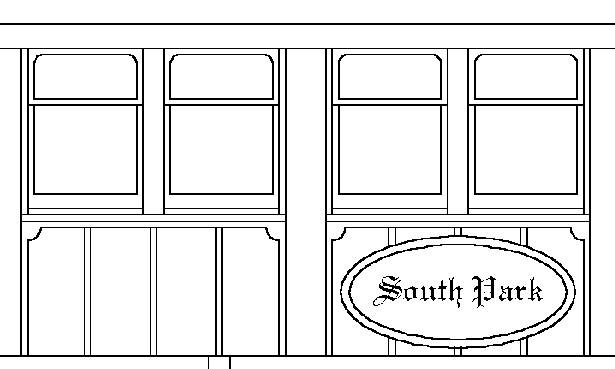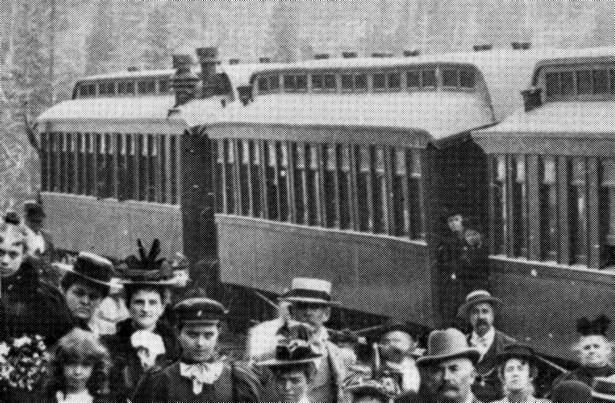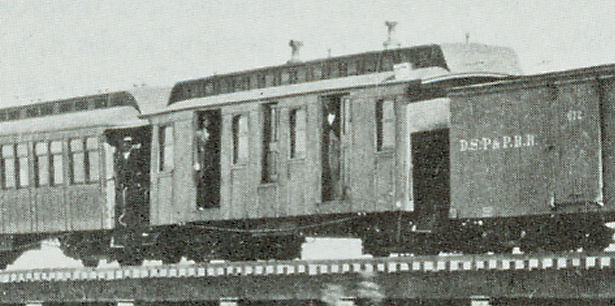Pullman Palace Car "South Park"
|
|
“The new Pullman palace car recently built at Detroit for the Denver & South Park railroad . . . is the first narrow gauge Pullman ever constructed for any road. It is named the South Park and is a very handsome car, built very similar to the standard popular sleepers of the broader gauges. The body of the coach is eighteen inches narrower than those built for the standard, and the aisle in proportion. The berths are also smaller than in the larger cars, and are each intended to hold but one person. The exterior of the car is painted the regulation color and ornamented in the Eastlake style. The interior is elaborately finished in mahogany, upholstered in crimson plush, hung with silk curtains and fitted with silver-plated rods and lamps. The ceiling is handsomely frescoed, and the interior arrangements are elaborate and are strictly first-class. The South Park is the forerunner, as it were, of a numerous band to come. Three more sleepers of precisely the same construction have been ordered, and are expected to arrive in a few days.” |
The “regulation color” of the Pullman company at that time was described in 1877 as a “maroon”, and in 1884 by the railroad trade press as “a dark plum.” The Eastlake style was a simpler style than previously used, with ornamentation provided by patterns incised into the wood or created by contrasting colors rather than the voluptuous carvings of prior years.
The South Park had double pane windows with only the tiniest rounding of the upper pane. It had not true board-and-batten siding, but a very distinctive type of paneling (see below). The platform roofs had the bullnose profile which seems to have been typical of Pullman-built cars. The South Park’s wheels were unusually large for a narrow gauge car, being 30" in diameter (compared to the usual 24" or 26") and were of a new type called “paper wheels.”
 |
|
Illustration of paneling on sides of South Park and other plan 73 Pullman Palace sleeping cars. Paneling would generally be ½" to ¾" thick with decorative “battens” 3/8" to ½" thick. It was prone to cup and check no matter how many coats of varnish it got, especially in the temperature extremes of the Colorado mountains. Unfortunately, since the next photos we have of these cars are as much as 15 years later, we can’t say how long it lasted before being replaced with the more utilitarian tongue-and-grove beaded “railroad” siding. Actually, from the look of those photographs, the original paneling below the windows may have been overlaid by the new siding. |
HISTORY
Pullman Palace car South Park was the first narrow gauge sleeping car built by the Pullmans Palace Car Company. It was the first of four cars built in October and November of 1879 as Pullman’s lot #61 for service on the Denver, South Park & Pacific Railroad. The other cars in lot #61 were the Bonanza, the Leadville and the San Juan. All were built to Pullman plan 73, which was modified a year later and apparently used thereafter only in the modified form.
The South Park, delivered in October 1879, together with the three Pullman Palace cars delivered a month later, were probably used more-or-less as parlor cars until the South Park began regular daily service to Leadville nine months later (June 1881), and possibly even after. These cars were not owned by the South Park, but were operated under contract with the Pullmans Palace Car Company (see The Pullman Sleeping Cars page for details).
We have no information as to which of the cars was operated on what routes, but apparently there was enough traffic that just before sleeper service was inaugurated between Denver and Gunnison the next year (October 1882), two more sleepers had to be assigned by Pullman.
The sleeping car business was lucrative, and Pullman was making most of the money, so many of the railroads forced Pullman to form “associations” that gave them a share of the profits. The Union Pacific did this in May 1884, and ownership of the South Park passed to the Union Pacific Association. The South Park was accordingly neither numbered or renumbered by the Union Pacific in 1885.
In July 1887, sleeper service to Gunnison was discontinued, with the sleeper going only as far as St. Elmo. But in November sleeper service on the Gunnison Division was completely discontinued.
@
In January 1889, the two newer sleepers ( were withdrawn from the Association to be rebuilt for service elsewhere.
@
By 1890 there must have been no sleeper service left, because it was proposed that the idle narrow gauge Pullmans be used on the night freight to Leadville. The idea was shelved, perhaps because of the absurdity of someone trying to sleep at the end of a train of freight cars jerked along by link-and-pin couplings. The only use of the Pullmans was on specials, and on the Alpine excursions which involved overnight travel for two nights. [Poor
In March 1892, the South Park and the remaining two of the four original Pullman sleepers were sold by the Association to the Union Pacific Railroad. They were converted to coaches, and in September of that year sold to the Union Pacific, Denver & Gulf. DSP&P Pullman South Park would, for a short time at least, be UPD&G coach #176.
(Looking at the floor plan of #910 as presented by the C&S passenger car diagram, and comparing its appointments as a private car with those as a Pullman Palace sleeping car, we doubt this “conversion” amounted to anything more than removing the upper berth apparatus and replacing the lavatory facilities at either end with additional seats and the more standard small toilet area.)
 |
|
(2) We originally said there’s a two-out-of-three chance one of these two coaches is ex-Pullman Palace sleeper South Park. We now feel sure the one on the left is the South Park during its short (1892-1894) stint as UPD&G coach #187. It has the characteristic twin “stacks” evident in the 1895 photo of it as UPD&G business car #1 on the next page (photo #3). But the two individuals leaning on the window sills make us think it has not yet been converted to a business car. This image is part of a photo by H.H. Buckwalter, taken at the Atlantic Siding. It can be found at Digerness2-322/23, Ferrell/SoPk-153, Kindig-311(u) and Speas-80. (The one in Digerness is by far the best, being a large two-page spread.) Digerness dates it 1894, Ferrell 1895, Kindig late 1890s, and Speas 1898. We often disagree with Digerness’ captions, but this time we think he’s right. But no big deal. If the others are right then the car is still South Park, but now in the guise of UPD&G business car #1. |
